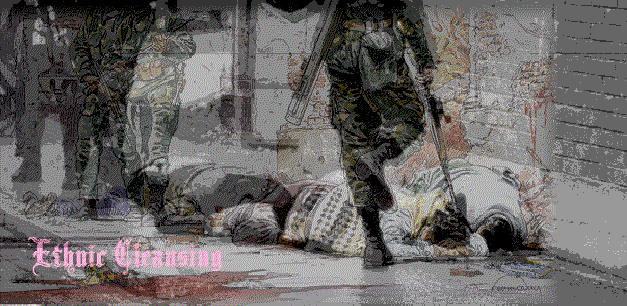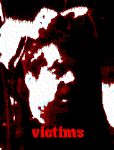

More than two hundred thousands civilians have been killed in Bosnia and Croatia since the beginning of the war. Tens of thousands of women were raped, some of them more than a hundred times, while their sons and husbands were beaten and tortured in concentration camps like Omarska and Manjaca. Millions lost their homes due to a process called "ethnic cleansing."
|  Ethnic Cleansing is a process in which advancing army of
one ethnic group expels civilians of other ethnic groups from towns and villages it conquers in
order to create ethnically pure enclaves for members of their ethnic group. Serbian military
commander in Bosnia, a war criminal sought by the War Crimes Tribunal in The Hague, Ratko Mladic, sometimes issued specific orders (.wav file in Serbian, 1'30", 1 MB) to his subordinates to
shell a particular village more than others, because there is less Serbs and more Muslims living
there. Often, refugees of one ethnic group previously "cleansed" from their homes by other
ethnic group are made to live in freshly "cleansed" teritory of that other ethnic group. The
vengeance they feel explains some of unusual cruelties this war brought to us. Without
possibility to get feedback on their actions from the world outside, their perpetuated hatred
serves their leaders purposes by providing reasons for continuation of the war. Click here to see the ethnic map of former Yugoslavia before ethnic
cleansing (200+kb). Click here to see the ethnic map of
former Yugoslavia today (large graphics, updates monthly, not extremely accurate), after the Dayton agreement. Ethnic Cleansing created more than two million refugees and
displaced persons in former Yugoslavia during the war in Bosnia. This number increased with the expulsion of Serbs from Croatia and with the ferocious atrocities committed by Serbs against the Albanian majority in Kosovo, prior and during (in spite of) NATO air strikes. Ethnic Cleansing is a process in which advancing army of
one ethnic group expels civilians of other ethnic groups from towns and villages it conquers in
order to create ethnically pure enclaves for members of their ethnic group. Serbian military
commander in Bosnia, a war criminal sought by the War Crimes Tribunal in The Hague, Ratko Mladic, sometimes issued specific orders (.wav file in Serbian, 1'30", 1 MB) to his subordinates to
shell a particular village more than others, because there is less Serbs and more Muslims living
there. Often, refugees of one ethnic group previously "cleansed" from their homes by other
ethnic group are made to live in freshly "cleansed" teritory of that other ethnic group. The
vengeance they feel explains some of unusual cruelties this war brought to us. Without
possibility to get feedback on their actions from the world outside, their perpetuated hatred
serves their leaders purposes by providing reasons for continuation of the war. Click here to see the ethnic map of former Yugoslavia before ethnic
cleansing (200+kb). Click here to see the ethnic map of
former Yugoslavia today (large graphics, updates monthly, not extremely accurate), after the Dayton agreement. Ethnic Cleansing created more than two million refugees and
displaced persons in former Yugoslavia during the war in Bosnia. This number increased with the expulsion of Serbs from Croatia and with the ferocious atrocities committed by Serbs against the Albanian majority in Kosovo, prior and during (in spite of) NATO air strikes.Although Serbs were by far the most succesful "cleansers," all sides adopted this method in the course of war. Record ethnic cleansing operations were Serbian Operation Horseshoe in Kosov@ and Croatian Operation Storm in Krajina. Bosnian capital Sarajevo, which so far escaped the "cleansing," has been under seige for over 1000 days, with more than 10 000 people killed and 50 000 injured. Check here what various human rights organizations have on the record. At the beginning of 1997 there still are more than 21,000 people in Bosnia missing. As of May 1, 2005, ten years after the war has ended, total number of persons, for whom International Committee of the Red Cross tracing request was opened by their families, and for which by that date no additional information was received, was 14,444. |
From the well-documented stories of a great many cities and towns and villages, dating back to the cleansing of the Krajina of Croats during 1991 and 1992, one can extract a rough standard operation.
Percentages of Bosnians actually killed varied widely, partly according to the strategic value of the target.
Picture credit: © 1992 Ron Haviv, Saba Press Photos
Bjeljina, Bosnia and Herzegovina, April 1992, victim's perspective: a Serb irregular kicks the
body of a Muslim woman executed seconds after coming to the aid of her husband, another
victim. During the occupation of Bjeljina, a primarily Muslim town, Muslims were "cleansed"
from their homes. The entire photograph (here only the lower half is used) is a part of the
TIME-LIFE Faces of Sorrow: Agony in the Former Yugoslavia
exhibition. Drawing that covers the photo is from Hermann Dupuis comic book available over the net.
 .
.